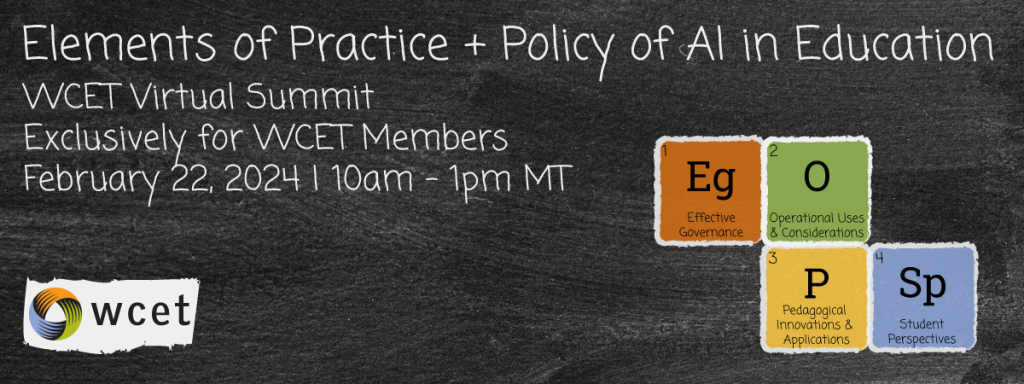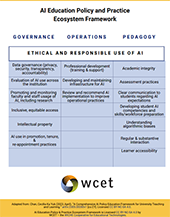Unveiling the Highlights: WCET’s 2024 Virtual Summit
Published by: WCET | 3/7/2024
Tags: Artificial Intelligence, Student Success, Teaching, Technology, Virtual Summit, WCET
Published by: WCET | 3/7/2024
Tags: Artificial Intelligence, Student Success, Teaching, Technology, Virtual Summit, WCET
A few short weeks ago, WCET staff, presenters, and members joined together for presentations and discussions about the policy and practice of Artificial Intelligence in Higher Education.

The event, which was exclusively offered to WCET members, took place on February 22, 2024. I was not involved in the planning and implementation of this Summit, so while I was invited to serve as a moderator for the session chats, I had no previews of the session content.
That’s why when I say it was a wonderful event that was a pleasure to attend, I may be a little biased (and super proud of my team members who did all of the planning), but not by much. I was simply impressed by the work that went into the event, the amazing presenters and facilitators, and the interaction of the attendees.
This event was particularly significant for higher education practitioners at this moment in time. We’ve started to learn about the highs and lows of AI in higher education, ranging from creative and promising applications to enhance student learning and success, to questions about the use of AI in ways that may not meet academic integrity standards and policies. Students see how AI benefits those in the workplace and want to understand and learn how to use it while they are in school. We see the potential issues when it comes to implicit bias in technologies such as AI and the inherent inequities that exist due to disparities in access to current technological tools, capabilities, and resources. Events such as this year’s Summit provide us with the opportunity to collectively learn from experts and leaders in our field, post questions to both these individuals and fellow attendees, and engage in conversations that benefit everyone.
We started the day with a welcome and introduction from Van Davis, Chief Strategy Officer for WCET.

Van showcased WCET’s new AI Policy Toolkit, available exclusively to WCET members, and the accompanying AI Policy Framework, which is openly available.
It’s time to consider the strategic use of AI, and that use should align with the values of our institution or organization. For example, despite the numerous and exciting possibilities AI presents for enhancing accessibility, it’s important to acknowledge that not all of your students and staff may have screen readers compatible with the latest tools. Accessibility policies should be reviewed with this in mind.
The sessions continued with a conversation about effective governance for AI in Higher Education with Gloria Niles, Karen Watté, and Michael K. Moore. This was an insightful discussion concerning the guidelines formulated by their institutions for the utilization of AI by students and staff. The speakers also elaborated on the various groups of stakeholders involved in the development of their guidelines and policies. Gloria and Karen provided lessons learned from their experiences with AI governance.
Conversations about the governance of AI should come early and make sure those in the conversations represent the entire institution. A small task force that can be flexible and responsive is helpful.
In our next session, Asim Ali, Sheenah Hartigan, and Corey Edwards highlighted the practical applications of AI and provided specific examples of AI use for their colleges and universities. I appreciated learning about the real ways AI is being used to assist with recruitment, student support, admissions, and more.
AI tools can offer valuable support to staff and faculty, which creates additional time to work on more substantial matters or work one-on-one with more students.
Don’t fear AI technology – it’s coming whether we’re ready for it or not. Join the conversations at your institution or organization. It’s the people who drive the implementation of the technology that will make or break its success. AI is highly capable, but it can’t completely implement itself.
The penultimate session of the Summit focused more on the pedagogical side of using AI and showcased outstanding and innovative approaches that leverage AI to improve teaching and learning.
It’s time to initiate our own learning and development about AI. And we should actively help our students learn more about these technologies. AI is being used in the workplace already, and we need to help prepare students to utilize these tools ethically and successfully. Keep an open growth mind when it comes to learning about this (and other) technology, starting from a closed and uninformed mindset will only impede your personal growth and that of your students.

While all the sessions were top-notch, the final session of the day was my favorite. I adore my job and team but often miss working with students, so it makes sense that getting to hear directly from students about their views and concerns about AI was a great way to end the day.
The students who presented, Joe Rendon and Chrischen Thompson, who are currently serving as SAN and Every Learner Everywhere interns, spoke eloquently and knowledgeably about the many uses of AI for students and when each of them uses AI. The use cases included brainstorming a project or piece of writing or helping them process their thoughts about an assignment. They ask questions about formatting and sometimes get ideas for an outline or structure for a paper.
The students cautioned us that it is important to teach students how to write good prompts to use with generative AI and also to make sure that you and your students use the most up-to-date tools. If the AI platform you use is not up-to-date, you run the risk of receiving outdated outputs.
Students want their colleges and universities to specifically detail when it is okay to use AI and when it is not, especially between different courses. The students said that sometimes different classes have different expectations and standards for using AI, and while that’s fine, that information must be clearly communicated and consistently available for reference. All of us need to keep privacy and data protection in mind when working with these tools. I was particularly interested to hear one of the students say that at times they do worry about using AI too much and that they won’t learn as much as they may have in working completely on their own.
We must clearly outline our expectations for students regarding the use of AI when completing assignments or assessments. The information should be included in the class syllabus, whether it is a class-specific policy, departmental guideline, program-level requirement, or institutional standard. Add a conversation about AI to the time you discuss the syllabus. These approaches will help students see the positives and negatives about using AI for their work, so they can understand when it is helpful and ethical to use these tools.
At the end of session 5, Van Davis came back on the screen to thank the students and to wrap up the day. Thank you, Van, for concluding the event and recapping the crucial topics discussed throughout all of the sessions.
WCET would like to thank and celebrate the speakers and facilitators who participated in this year’s summit. We genuinely appreciated hearing about your experiences, thoughts, and feelings on AI in higher ed. We would also like to thank and applaud our attendees for their engagement, questions, and the sense of community they helped us foster during this event.

Here are the takeaways I included for each session:
Did you attend this year’s Summit? If so, thank you for learning with us. If you weren’t able to attend, don’t worry, we have lots of great events coming up soon!
WCET Webcast: Accessibility in EdTech: How Do Your Products Rate? – 3/13/2024
WCET Webcast: Seismic Shifts in Distance Ed Regulations: Gauging Department of Education Rulemaking – 3/20/2024
WCET Webcast: AI Ethics, Governance, Policy, and Practice in Higher Education: A Strategic Webcast for Leaders and Practitioners – 4/4/2024
Meeting: Distance Ed at a Crossroads: The Changing Landscape of New Regulations – July 30, 2024 – July 31, 2024
Meeting: WCET 36th Annual Meeting – 10/8/2024 – 10/10/2024 **Session Submissions are Now Open! The deadline for submissions is 4/2/2024.
Keep up with all of our events at wcet.wiche.edu/wcet-events!